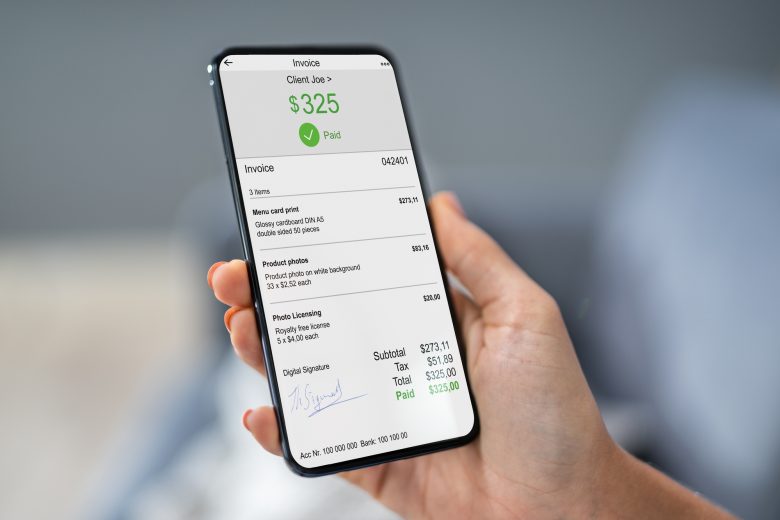As a startup company that takes themselves seriously, you’ve set up an efficient administration team who know how to manage their time so that operations run smoothly; so that you have the foundation from which to build the business you’ve imagined.
In most cases, companies have to spend money to make money. Even if a customer has made a deposit, you’ll have to make an additional investment to buy or make the product you’re selling or deliver your services. For example, you have a business that makes customized clothing; once you’ve received an order, you’ll have to make an initial outlay for the material you’ll need to put a piece together. Perhaps you have a building maintenance company and have a paint job to do? Again, you’ll have to spend money on the supplies needed to get it done.
Your order book is looking good, and operations are underway to deliver on your commitments. You’ve stuck to your turnaround time and delivered to your client in good faith. However, weeks have passed, and the client is not settling their outstanding balance. Month-end is now approaching, and you have to pay bills, but your bank balance is looking precariously low.
Let’s look at how, as a company owner, you can put measures in place to safeguard your income so that your focus remains on getting your brand on as many lips as possible and your product or service sold.
Commitment from the client:
Building a profitable company doesn’t only depend on having a winning product, stellar service, or sound operations; it depends on building mutually beneficial business relationships where you secure long-term business. Repeat business ensures that clients honor their payment commitments to have future access to your indispensable product or service.
- Issuing purchase orders. The buyer (your customer) issues this document to the supplier (you) to confirm that they have ordered from you. You can request this from a client to ensure that the law covers you should a customer not pay. The incentive for them to agree to and sign a purchase order is that expectations are set where they are assured that they will receive what they’ve ordered.
Besides an order number, this record includes the client’s contact information, date of order, description of goods or services, quantity, price, payment details, shipping address, and delivery date.
- Establishing payment terms. As a business owner, one of your primary roles will be to carefully cost your product or service, where, if you undercharge to make sales, you stunt your company’s growth because you’re just breaking even. On the other hand, you could deter potential clients by overcharging. Once you’ve got your pricing right, you then have to decide on whether or not you’ll require a deposit from customers and, if so, on what condition. It depends a lot on the type of operation you run. For example, if you sell a commodity with short delivery timeframes, such as freshly made pasta, it’s more practical to request upfront payment. If instead, you’re a furniture maker, you could agree to a 50% deposit to start with and the rest upon completion of the project.
- Offering different payment options. In today’s cutthroat and fast-paced economy, convenience is what will set you apart from your competitors. Payment options are no longer limited to cash or card. With an increasing number of businesses operating online, you’ll have to stay current by offering your clients the option to pay via Electronic Funds Transfer. Another way that companies are increasing their business potential these days is by giving customers the option to pay in increments.
Besides adopting the above measures to secure payment for the products and services you’ve provided, it’s in the company’s best interest to do a background check on new customers to get an idea of their payment history. For example, you could reach out to suppliers who deal with or have dealt with the client in the past to find out whether they are financially fit enough to pay for their business needs.
When clients don’t pay:
In an ideal world, client expectations are always met, and companies receive payment on time, every time. And, although we would like to believe that everyone has good intentions, even if they do, they may be experiencing unexpected cashflow problems where they can’t honor their repayment commitments.
In the event that a client has made a commitment by paying a deposit, but there has been no follow-through on settling their account after you’ve delivered the goods or provided the service, these are some of the options to consider:
- Charge interest. An important detail you may want to include in your invoice is that you’ll charge interest if clients don’t pay on time. The prospect of having to pay additional fees gives customers reason to settle their accounts on time.
- Exchange of product or service. If the client is genuinely concerned about settling their debt with you and has proved this by maintaining contact with you or your accounting department, you could ask for some sort of trade-off. It depends on what business they’re in and whether or not they can provide something worthwhile to yours. For example, say you run a delivery company and haven’t received payment from the customer for months now; besides discontinuing their service, you could request credit for goods to the value of what they owe you.
- Write off. If, after numerous attempts of requesting the monies owed to you, there has been no movement, you may decide to cut your losses and cancel their payment obligation to get that bad debt off of your books.
- Legal route. This option depends on the amount of funds owed, which you will have to use as a measure to decide whether it will be worth spending the legal fees required to recover the outstanding balances.
As a business owner, your responsibilities include ensuring that your company can always cover the daily, monthly, and yearly expenses to remain operational. To do this, you’ll have to decide which risks are worth taking and how to manage them.
We’ve seen that putting measures in place like issuing purchase orders, establishing payment terms, and offering different payment options decreases the likelihood of not getting paid for your product or service.
We also had a look at the options available to you when clients default on their payments to give you the best chance of getting paid for the valuable products and services you provide.











Pingback: Top Under The radar Secrets To Create A Successful Home Based business Enterprise(Product) ·
Pingback: Healthy Cashflow: Getting Paid and What to do When Clients Don't Pay - Amazon FBA Courses